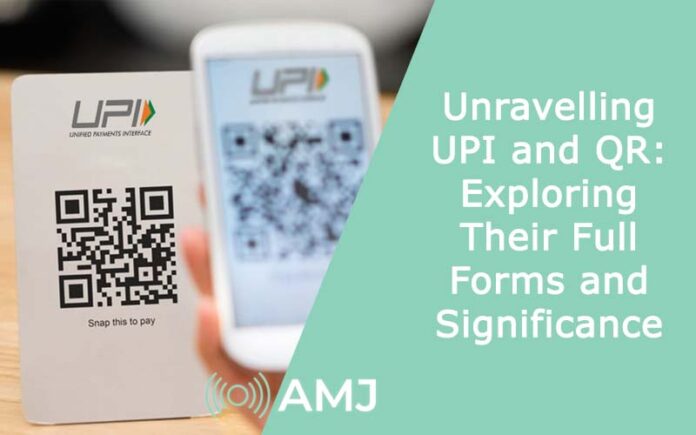
The UPI, or Unified Payments Interface, has gained immense popularity as a convenient and reliable payment system in India. Introduced in 2016, it has drastically transformed how people send and receive money, making digital transactions fast and easy. With UPI and QR codes, users can transact instantly without IFSC codes, bank details, and other tedious options. As the UPI full form indicates, it is a unified payment system that works efficiently across platforms. The user simply scans a code with their smartphone camera to authenticate the payment directly from their bank account.
In the following sections, we will unravel how UPI and QR codes have simplified payments, their benefits, and their significance.
Contents
What is UPI?
UPI full form is Unified Payments Interface, a payment system facilitating instant money transfers between bank accounts through a mobile platform. The National Payments Corporation of India (NPCI) developed this digital payments platform with support from the RBI to enable instant money transfers securely and safely. Since it supports multiple banks across India, users can quickly switch accounts for payments within the UPI-enabled app.
What is a QR Code?
QR codes are two-dimensional barcodes that users can scan with their smartphone camera and quickly pay for bills, groceries, tickets, etc. Thanks to their widely accepted technology for making payments, they have become a popular payment medium in India. UPI provides users with a QR payment system, allowing them to use the vast potential of QR codes. They serve as efficient payment gateways, enabling users to make payments without needing physical cash.
Significance of UPI
The UPI has been a game-changer in the country’s digital payment system, revolutionizing transactions and creating a cashless economy. It is a government-backed payment system that drives financial inclusion and promotes digital literacy, making India a digitally empowered country. Here, we will highlight the significance of UPI and discuss its impact on various sectors:
- Instant Transactions: The user can pay instantly after quick registration, and the payment is reflected in the receiver’s account within seconds. Thus, it is a time-saving payment system that lets users instantly conduct high and small-value payments.
- No Cash Involved: UPI is a revolutionary digital payments system that allows instant peer-to-peer, merchant, and inter-bank transfers. Since it handles transactions digitally, users don’t need paper cash.
- Cashback and Rewards: Aiming to capture attention, UPI-enabled platforms offer cashback and rewards on various transactions, enhancing the user’s savings. When users can redeem discount codes on shopping, UPI transfers cashback to their account instantly and directly after the transfer.
- Boost to E-commerce: UPI has significantly fuelled the growth of the e-commerce sector in the country. The convenient and secure payment methods have facilitated seamless digital transactions, allowing customers to shop online confidently. The UPI integration with e-commerce platforms expands the business’s customer base and facilitates quick and hassle-free payments. Ultimately, it contributes to the growth of the digital commerce ecosystem in India.
- Protection: UPI platforms implement advanced solutions to secure transactions and protect users’ data.
Significance of QR Payment System
The QR payment system offers several advantages, including the following:
- High Transaction Limits: A high transaction limit is one of the most significant advantages of using QR codes. The high transaction limit of up to Rs. 2 Lakh is above most other mobile payment platforms. QR is an ideal payment solution for individuals and businesses with frequent payment needs.
- Fast Transactions: The QR code full form is a Quick Response code. As its name suggests, it facilitates faster transactions than most other payment systems in India. Once the user scans the QR code, the transfer takes place within 5-10 seconds, making it one of the most time-efficient payment methods. With a QR code, real-time payments occur while ensuring seamless transactions.
- Complete Privacy and Security: Privacy and security are the two major concerns when making digital payments. The QR code system uses multiple security layers to secure transactions. Unlike traditional methods of payment where users had to enter their mobile number and bank account details, QR code uses a VPA (Virtual Payment Address) to identify the account and complete the transaction. It is like an email address connected to the user’s account, thus ensuring high security and confidentiality.
- No Hidden Charges: Users are often concerned about additional payment-related charges when making online transactions. However, the QR payment system is devoid of hidden charges. The system does not charge any transaction fee from the sender or the recipient, making it an affordable payment system for everyone.
- Dynamic QR Codes: Dynamic QR code is one of the latest innovations in digital transactions. These unique QR codes provide an enhanced security level with high flexibility. These codes are unique for each scan, ensuring security for every transaction. These codes use specific algorithms to generate new codes for each scan, preventing any chance of fraud.
Future Prospects
The wide acceptance and success of UPI and QR payment systems support further advancements in the country’s digital payments ecosystem. As they continue gaining popularity among users, exciting prospects await their future development. Some potential growth areas include the following:
- Integration with Additional Services: UPI and QR provide a comprehensive platform to users for various services, including bill payments, insurance, investments, etc. Integration with multi-faceted services will streamline financial management and boost users’ convenience.
- Expansion to Global Markets: The success of UPI and QR in India instigates their potential for global remittances. The UPI infrastructure may facilitate international transactions, making cross-border payments more secure, cost-effective, and faster.
- Enhanced Security: UPI and QR may implement additional security measures to mitigate risks and threats as they evolve. AI, biometrics, and tokenization strengthen transaction security, ensuring user confidence and trust.
The UPI and QR payment systems have taken the Indian digital payment sector by storm. They help users enjoy a convenient, fast, and secure payment method. Moreover, they offer higher transaction limits than other platforms, and the transactions occur in 5-10 seconds. Additionally, the transactions are free of additional charges and ensure complete privacy and security. With the introduction of UPI and dynamic QR codes, digital payments have become accessible to everyone, irrespective of their financial situation and location. QR and UPI’s full form indicates a bright future for digital payments in India and abroad.












![Index of Money Heist [Season 1, 2, 3 & 4 – All Episodes, Cast and Plot] Index of Money Heist](https://www.asiamediajournal.com/wp-content/uploads/2021/05/Index-of-Money-Heist-3-100x70.jpg)